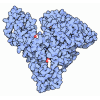Entry Database : PDB / ID : 1xv9Title crystal structure of CAR/RXR heterodimer bound with SRC1 peptide, fatty acid, and 5b-pregnane-3,20-dione. Orphan nuclear receptor NR1I3 Retinoic acid receptor RXR-alpha nuclear receptor coactivator 1 isoform 1 Keywords / / / / Function / homology Function Domain/homology Component
/ / / / / / / / / / / / / / / / / / / / / / / / / / / / / / / / / / / / / / / / / / / / / / / / / / / / / / / / / / / / / / / / / / / / / / / / / / / / / / / / / / / / / / / / / / / / / / / / / / / / / / / / / / / / / / / / / / / / / / / / / / / / / / / / / / / / / / / / / / / / / / / / / / / / / / / / / / / / / / / / / / / / / / / / Biological species Homo sapiens (human)Method / / / Resolution : 2.7 Å Authors Xu, R.X. / Lambert, M.H. / Wisely, B.B. / Warren, E.N. / Weinert, E.E. / Waitt, G.M. / Williams, J.D. / Moore, L.B. / Willson, T.M. / Moore, J.T. Journal : Mol.Cell / Year : 2004Title : A Structural Basis for Constitutive Activity in the Human CAR/RXRalpha Heterodimer.Authors : Xu, R.X. / Lambert, M.H. / Wisely, B.B. / Warren, E.N. / Weinert, E.E. / Waitt, G.M. / Williams, J.D. / Collins, J.L. / Moore, L.B. / Willson, T.M. / Moore, J.T. History Deposition Oct 27, 2004 Deposition site / Processing site Revision 1.0 Dec 28, 2004 Provider / Type Revision 1.1 Apr 30, 2008 Group Revision 1.2 Jul 13, 2011 Group Revision 1.3 Nov 30, 2016 Group / Source and taxonomyRevision 1.4 Feb 14, 2024 Group / Database references / Derived calculationsCategory chem_comp_atom / chem_comp_bond ... chem_comp_atom / chem_comp_bond / database_2 / struct_ref_seq_dif / struct_site Item _database_2.pdbx_DOI / _database_2.pdbx_database_accession ... _database_2.pdbx_DOI / _database_2.pdbx_database_accession / _struct_ref_seq_dif.details / _struct_site.pdbx_auth_asym_id / _struct_site.pdbx_auth_comp_id / _struct_site.pdbx_auth_seq_id
Show all Show less
 Yorodumi
Yorodumi Open data
Open data Basic information
Basic information Components
Components Keywords
Keywords Function and homology information
Function and homology information Homo sapiens (human)
Homo sapiens (human) X-RAY DIFFRACTION /
X-RAY DIFFRACTION /  SYNCHROTRON /
SYNCHROTRON /  MOLECULAR REPLACEMENT / Resolution: 2.7 Å
MOLECULAR REPLACEMENT / Resolution: 2.7 Å  Authors
Authors Citation
Citation Journal: Mol.Cell / Year: 2004
Journal: Mol.Cell / Year: 2004 Structure visualization
Structure visualization Molmil
Molmil Jmol/JSmol
Jmol/JSmol Downloads & links
Downloads & links Download
Download 1xv9.cif.gz
1xv9.cif.gz PDBx/mmCIF format
PDBx/mmCIF format pdb1xv9.ent.gz
pdb1xv9.ent.gz PDB format
PDB format 1xv9.json.gz
1xv9.json.gz PDBx/mmJSON format
PDBx/mmJSON format Other downloads
Other downloads 1xv9_validation.pdf.gz
1xv9_validation.pdf.gz wwPDB validaton report
wwPDB validaton report 1xv9_full_validation.pdf.gz
1xv9_full_validation.pdf.gz 1xv9_validation.xml.gz
1xv9_validation.xml.gz 1xv9_validation.cif.gz
1xv9_validation.cif.gz https://data.pdbj.org/pub/pdb/validation_reports/xv/1xv9
https://data.pdbj.org/pub/pdb/validation_reports/xv/1xv9 ftp://data.pdbj.org/pub/pdb/validation_reports/xv/1xv9
ftp://data.pdbj.org/pub/pdb/validation_reports/xv/1xv9 Links
Links Assembly
Assembly
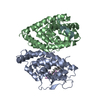
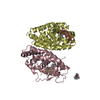
 Components
Components Homo sapiens (human) / Gene: RXRA, NR2B1 / Production host:
Homo sapiens (human) / Gene: RXRA, NR2B1 / Production host: 
 Homo sapiens (human) / Production host:
Homo sapiens (human) / Production host: 
 Homo sapiens (human) / References: GenBank: 22538455, UniProt: Q15788*PLUS
Homo sapiens (human) / References: GenBank: 22538455, UniProt: Q15788*PLUS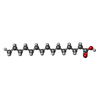
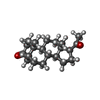



 X-RAY DIFFRACTION / Number of used crystals: 1
X-RAY DIFFRACTION / Number of used crystals: 1  Sample preparation
Sample preparation SYNCHROTRON / Site:
SYNCHROTRON / Site:  APS
APS  / Beamline: 17-ID / Wavelength: 1 Å
/ Beamline: 17-ID / Wavelength: 1 Å Processing
Processing MOLECULAR REPLACEMENT / Resolution: 2.7→50 Å / σ(F): 0 / σ(I): 0 / Stereochemistry target values: Engh & Huber
MOLECULAR REPLACEMENT / Resolution: 2.7→50 Å / σ(F): 0 / σ(I): 0 / Stereochemistry target values: Engh & Huber Movie
Movie Controller
Controller





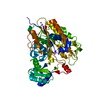

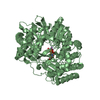
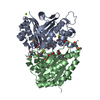
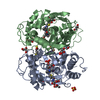
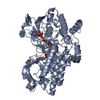
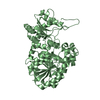
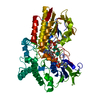
 PDBj
PDBj






